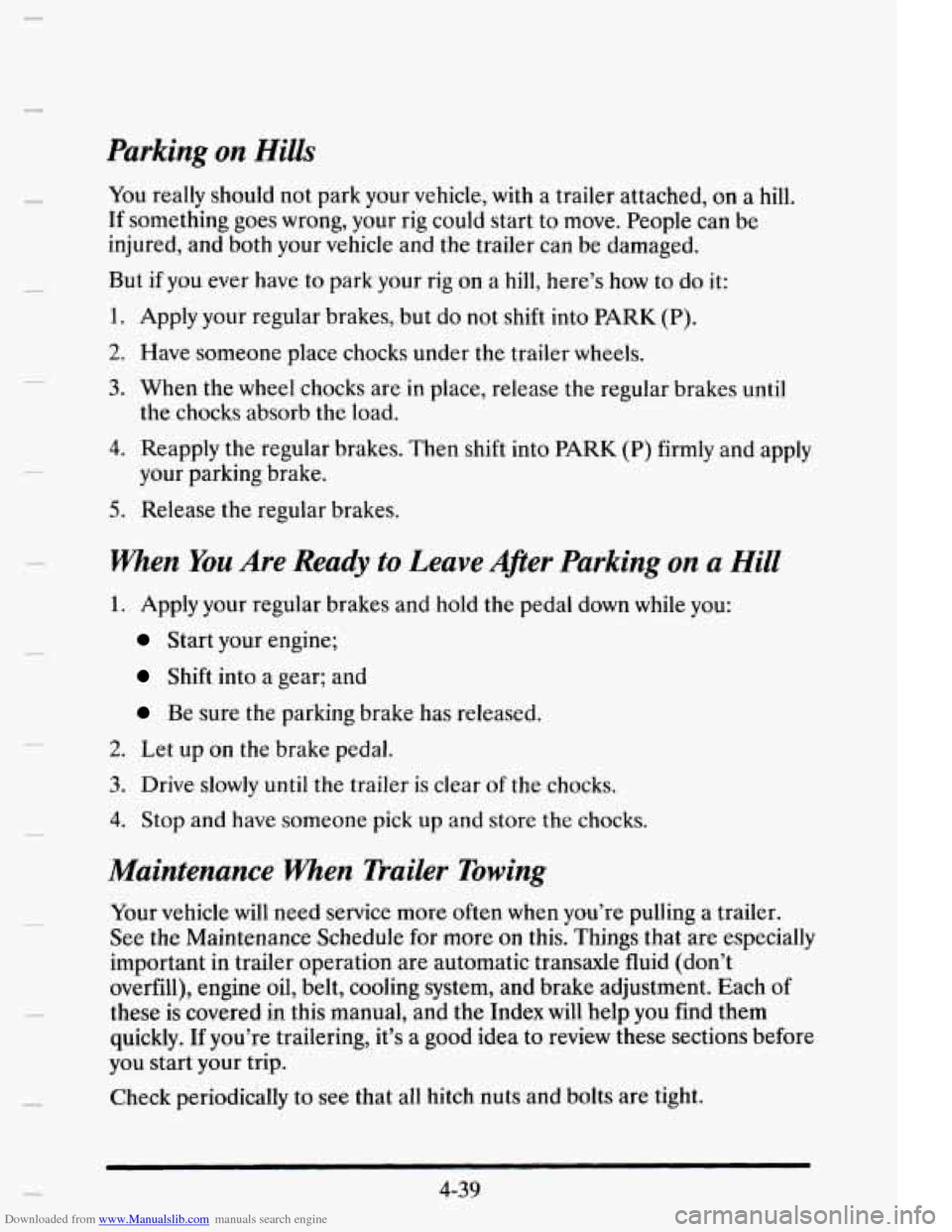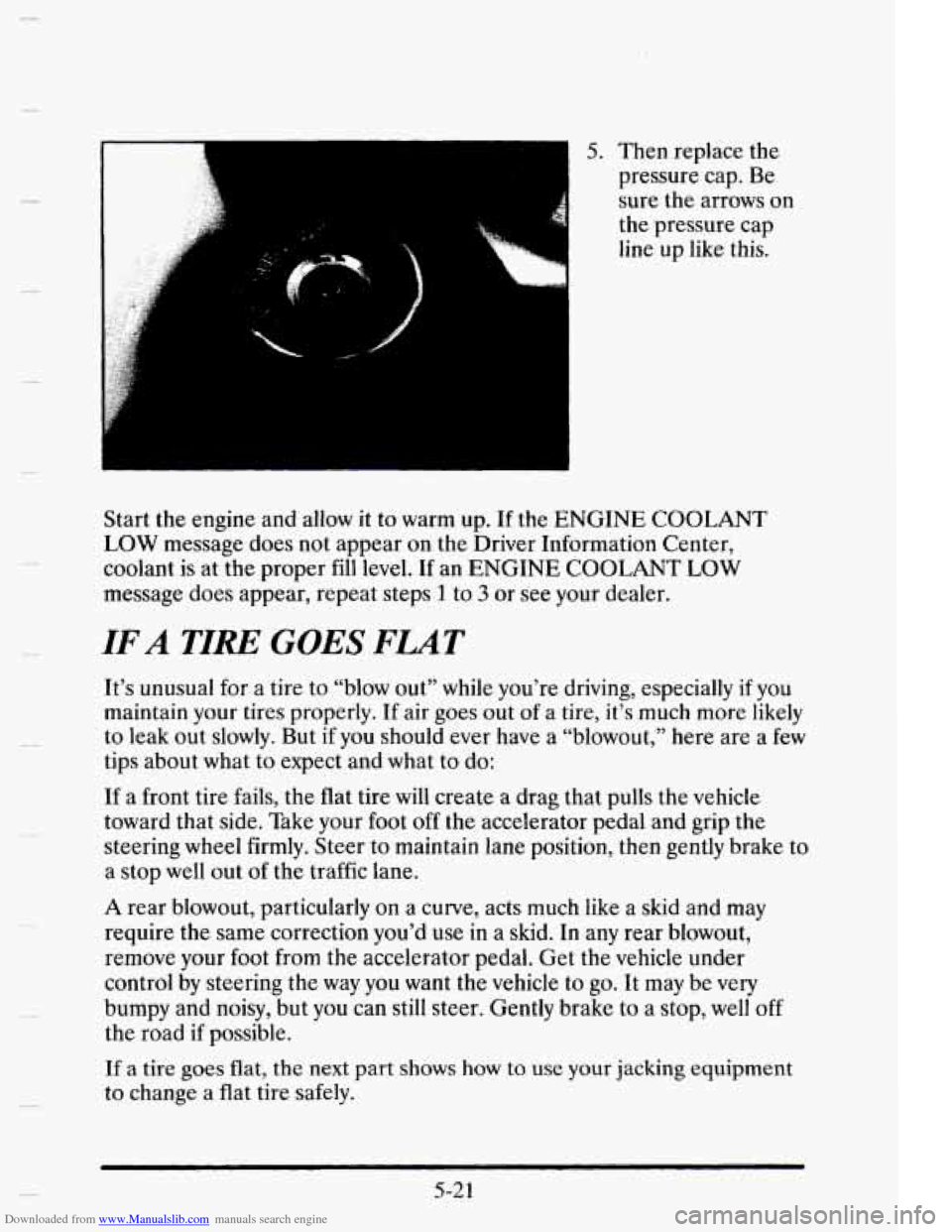Page 226 of 395

Downloaded from www.Manualslib.com manuals search engine Parking on Hills
c
You really should not park your vehicle, with a trailer attached, on a hill.
If something goes wrong, your rig could start to move. People can be
injured, and both your vehicle and the trailer can be damaged.
But
if you ever have to park your rig on a hill, here’s how to do it:
1. Apply your regular brakes, but do not shift into PARK (P).
2. Have someone place chocks under the trailer wheels.
3. When the wheel chocks are in place, release the regular brakes until
the chocks absorb the load.
4. Reapply the regular brakes. Then shift into PARK (P) firmly and apply
5. Release the regular brakes.
your parking
brake.
When You Are Ready to Leave Afier Parking on a Hill
1. Apply your regular brakes and hold the pedal down while you:
Start your engine;
Shift into a gear; and
Be sure the parking brake has released.
2. Let up on the brake pedal.
3. Drive slowly until the trailer is clear of the chocks.
4. Stop and have someone pick up and store the chocks.
Maintenance When Trailer Towing
Your vehicle will need service more often when you’re pulling a trailer.
See the Maintenance Schedule
for more on this. Things that are especially
important in trailer operation are automatic transaxle fluid (don’t
overfill), engine oil, belt, cooling system, and brake adjustment. Each
of
these is covered in this manual, and the Index will help you find them
quickly.
If you’re trailering, it’s a good idea to review these sections before
you start your trip.
Check periodically to see that all hitch nuts and bolts are tight.
4-39
Page 236 of 395
Downloaded from www.Manualslib.com manuals search engine n
c
TOWING YOUR VEHICLE
Try to have a GM dealer or a professional towing service tow your
Cadillac. The usual towing equipment is:
W
W
W
W W
Sling Type
Wheel Lift
Car Carrier
If your vehicle has been changed or modified since it was factory-new by
adding aftermarket items Iike fog lamps, aero skirting
or special tires and
wheels, these instructions and illustrations may not be correct.
Before you do anything, turn on the hazard warning flashers.
When you call, tell the towing service:
That your vehicle cannot be towed from the front or rear with
That your vehicle has front-wheel drive.
0 The make, model and year of your vehicle.
0 Whether you can still move the shift lever.
0 If there was an accident, what was damaged.
sling-type
equipment.
5-9
Page 238 of 395
Downloaded from www.Manualslib.com manuals search engine When your vehicle is being towed, have the ignition key off. The steering
wheel should
be clamped in a straight-ahead position, with a clamping
device designed for towing service.
Do not use the vehicle’s steering
column lock
for this. The transaxle should be in NEUTRAL (N) and the
parking brake released.
Don’t have your vehicle towed
on the front wheels, unless you must. If the
vehicle must
be towed on the front wheels, don’t go more than 35 mph
(56 km/h) or farther than 25 miles (40 km) or your transaxle will be
damaged. If these limits must be exceeded, then the front wheels have
to be supported on a dolly.
5-1 1
Page 248 of 395

Downloaded from www.Manualslib.com manuals search engine .. i
k
5. Then replace the
pressure cap. Be
sure
the arrows on
the pressure cap
line up
like this.
Start the engine and allow
it to warm up. If the ENGINE COOLANT
LOW message does not appear on the Driver Information Center,
coolant
is at the proper fill level. If an ENGINE COOLANT LOW
message does appear, repeat steps 1 to 3 or see your dealer.
IF A TIRE GOES FLAT
It’s unusual for a tire to “blow out” while you’re driving, especially if you
maintain your tires properly.
If air goes out of a tire, it’s much more likely
to leak out slowly. But
if you should ever have a “blowout,” here are a few
tips about what to expect and what to do:
If a front tire fails, the flat tire will create a drag that pulls the vehicle
toward that side. Take your foot
off the accelerator pedal and grip the
steering
wheel firmly. Steer to maintain lane position, then gently brake to
a stop well out of
the traffic lane.
A rear blowout, particularly on a curve, acts much like a skid and may
require the same correction you’d use
in a skid. In any rear blowout,
remove your foot from the accelerator pedal. Get the vehicle under
control by steering
the way you want the vehicle to go. It may be very
bumpy and noisy, but you can still steer. Gently brake to a stop, well off
the road if possible.
If a tire goes flat, the next part shows how to use your jacking equipment
to change a flat tire safely.
5-2 1
Page 249 of 395
Downloaded from www.Manualslib.com manuals search engine CHANGING A FLAT TIRE
If a tire goes flat, avoid further tire and wheel damage by driving slowly to
a level place. Turn on your hazard warning flashers.
p.
The following steps will tell you how to use the jack and change a tire.
5-22
Page 250 of 395
Downloaded from www.Manualslib.com manuals search engine 1. The equipment
you'll need is in the
trunk under the
spare tire cover.
Rotate the plastic
wing
nut and
remove the cover.
2. Remove the wing
nut that secures the
jack and wheel wrench and remove
them
from the
trunk.
5-23
Page 251 of 395
Downloaded from www.Manualslib.com manuals search engine 3. Attach the wheel
wrench
to the jack
bolt and rotate it
clockwise. That will
raise the lift head a
little.
r
4. There is a center
wheel cover
on your
aluminium wheel.
Using the flat end
of the wheel
wrench, gently pry
the cover
off. Be
careful not to
scratch the
aluminum wheel 1
edge. Don't try to
remove it with your
hands.
5 -24
a
J
Page 252 of 395
Downloaded from www.Manualslib.com manuals search engine 5. Using the wheel
wrench loosen all
the wheel nuts.
Don't remove them
yet.
6. Position the jack
under the vehicle.
Your vehicle has a
notch on the frame
near each
of the
wheels (A-front and
B-rear). Fit the lift
head into the notch
nearest the wheel
with the flat tire.
A CAUTION
Getting under a vehicle when it is jacked up is dangerous. If the
vehicle
slips off the jack, you could be badly injured or killed.
Never get under
a vehicle when it is supported only by a jack.
5-25